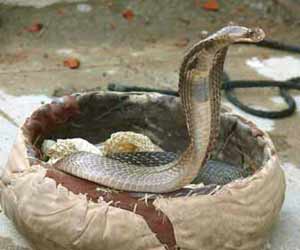Snake Milker Jobs
Snakes. Just the word will send chills down the spine of many people. Over 2,000 types of snake hide out on Earth, 400 of those snakes are venomous, deadly, reptiles. They slither and slide and are generally a creepy creature. Most people would choose to steer clear of snakes all together. Now it may sound crazy, but there are some people that choose to work with snakes – the deadly ones. They are called snake milkers.
Snake milkers have an insane job. They “milk” snakes for their venom. This means that every single day, a snake milker handles deadly, venomous snakes. It’s a hands on job where you put your fingers millimeters away from the sharp, fangs of asps, vipers, cobras, corals, mambas, kraits, and rattlesnakes. One slip of a finger and, well, its all over.
Snake venom does play an important role in science. It can be used for antivenoms and medicines. Snake milkers are actually doing something great for the world. The venom they extract can be used to create antivenom. So next time you’re wandering around Australia and get bit by a venomous snake, be sure to thank the local snake milker because an antivenom is the only thing that could save your life.
Newer medical research is showing that venom can be used in medicines to help with both strokes and malignant tumors. The venom of the pit viper is being used in a medicine called Viprinex that expands the window for treatment for stroke victims. As research continues, who knows how else we will use venom.
Snake milking is a dangerous job, but by saving lives it can be quite satisfying. During the day, you work in a serpentarium. A serpentarium is a place where snakes live. For work, you remove venomous snakes from their homes and “milk” them. This entails, stretching latex over a jar and having the snake bite the jar. The venom is extracted in two ways, manually massaging the venom glands or electric stimulation that contracts the muscles around the glands. Both ways cause a yellow, deadly venom to spit out into the jar. Next the venom is freeze-dried and used by or sold to pharmaceutical companies, laboratories, and universities for research and production.
Snakes have to be monitored as this process goes on. If you milk a snake too much, it is unhealthy. In the serpentarium, there are bunches of snakes. This means that a snake milker needs to milk multiple snakes every day. A snake milker is responsible for breeding the snakes too. More snakes increase the amount of venom that can be produced.
To become a professional snake milker, you need to have a degree in biology, chemistry, biochemistry, or herpetology (the study of reptiles). One of the leaders in this field is the Natural Toxin Research Center at Texas A&M University. Next learn about snakes. Take handling and identification courses. You also need to practice handling snakes. Just an idea, try to learn by handling non-venomous snakes first. It’s easier to make mistakes that way.
Snake milking is a regulated industry. The USDA regulates who can buy and sell snake venom. It is very important to learn about these regulations so that you can operate properly. On average, snake milkers make around $2,500 per month, but snake venom is an expensive market. One gram of certain types of snake venom can sell for $2,000.
If you are crazy enough to capture, milk, and breed snakes, please take the precaution to wear protective clothing and always have antivenom close at hand. And remember one mistake, and you will die.
Quick Facts About Snake Milking
Job Title: Snake Milker
Office: Controlled laboratory
Description: Extract venom from snakes to be used in antivenom
Certifications/Education: Degree in biology, biochemistry, or herpetology
Necessary Skills: Knowledge of snakes, Courage to milk dangerous snakes
Potential Employers: Universities, Laboratories, Pharmaceutical Companies
Pay: $2,500 per month
Helpful Snake Milker Employment Links:
Search Snake Milker Jobs on JobMonkey
Snake Getters
Snake Handler
Natural Toxins Research Center


 Teach English in Asia
Teach English in Asia  Cruise Ship Jobs
Cruise Ship Jobs  Alaska Fishing Industry Jobs
Alaska Fishing Industry Jobs  Sharing Economy / Gig Economy
Sharing Economy / Gig Economy 